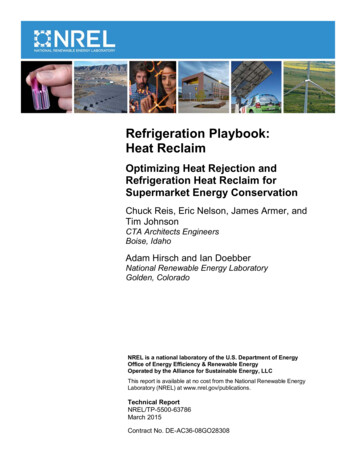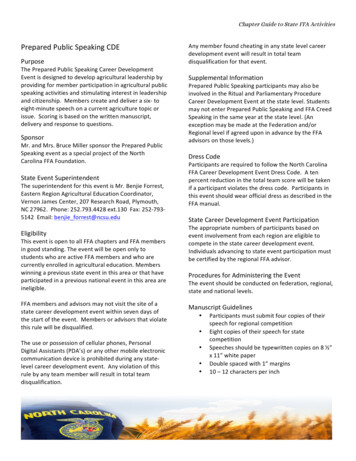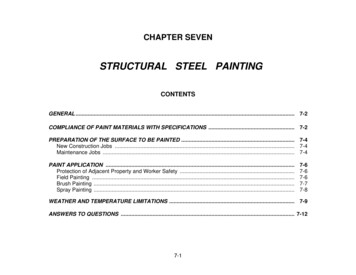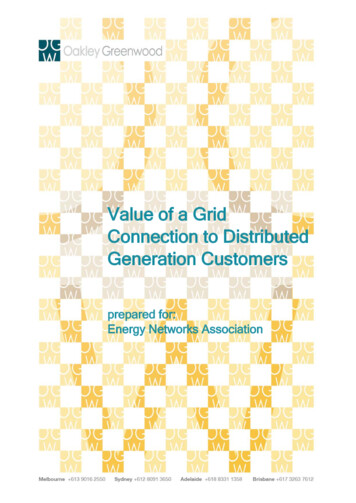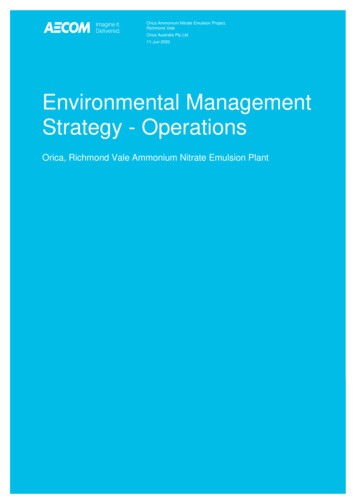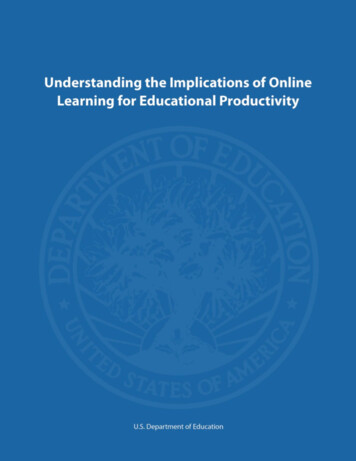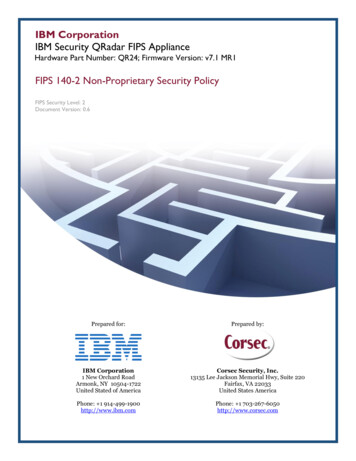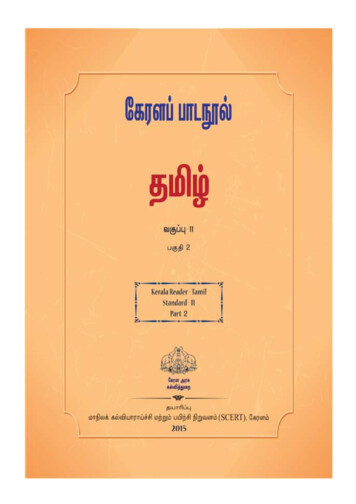
Transcription
TIONS FOR BEST PRACTICESin the Management of Elderly Disaster VictimsB AY L O RCOLLEGEOFMEDICINE Harris CountyHospital DistrictTHEAMERICANMEDICALASSOCIATION
CONTRIBUTORSCarmel Dyer, MD, FACP, AGSFAssociate Professor of MedicineBaylor College of MedicineDirector, Geriatrics ProgramHarris County Hospital DistrictCo-director of the Texas Elder Abuseand Mistreatment InstituteMaria Vogel, MSN, NP-CInstructor of MedicineBaylor College of MedicineNicolo A. Festa, MSWAdult Protective Service Program CoordinatorLouisiana Department of Health and HospitalsEllen E. Seaton, LMSWManager of Special Assistance ServicesHarris County Social ServicesChairperson for the Agencies for GerontologyIntercultural Field Training ConsortiumBoard Member of the National Associationof Social Workers – Texas ChapterBeth Cloyd, RN, MBAAdministrator, Medical ServicesHarris County Hospital DistrictMor Regev, BAResearch AssistantBaylor College of MedicineJoanne G. Schwartzberg, MDDirector, Aging and Community HealthAmerican Medical AssociationJames James, MDAmerican Medical AssociationAye Khaine, LMSW, ACSWSupervisor, Serenity House, Services to theAlone and Frail Elderly (SAFE)and AIDS MinistryCatholic Charities of the Archdioceseof Galveston-HoustonLee Poythress, MDAssistant ProfessorBaylor College of MedicineJason Burnett, MSResearch AssistantBaylor College of MedicineNancy L. Wilson, LMSWAssistant Director, Huffington Center on AgingAssistant Professor, Department of Medicine-GeriatricsBaylor College of MedicineChairperson, Care for Elders Governing CouncilJan Edwards, LCSWDirector of Case ManagementSheltering Arms Senior ServicesStacey Mitchell, MSN, RNSenior Forensic Nurse InvestigatorHarris County Medical Examiner’s OfficeMarilyn DixGrant WriterResearch and Sponsored ProgramsHarris County Hospital District
TABLEOFCONTENTSIntroduction . 1Uses of this report . 3Why the focus on frail elders and vulnerable adults? . 4The mortality associated with evacuation of elders . 5Literature review . 6Description of the Houston experience . 81) SWiFT—development of the team and the instrument . 82) Operationalizing the SWiFT system . 93) SWiFT screening tool . 104) Use of the SWiFT tool in the post-disaster phase . 115) Use of the SWiFT tool in disaster preparedness . 12Lessons learned . 14Recommendations for best practices . 20Appendices . 211) SWiFT screening tool . 212) Data tables . 22A. Harris County Deaths as a Result of Hurricane KatrinaB. Harris County Deaths as a Result of Hurricane RitaC. Demographics of Hurricane Katrina Patients served in theReliant Astrodome ComplexD. Descriptive Analysis of SWiFT Data3) Annotated bibliography . 31
1INTRODUCTIONOn August 29, 2005, Hurricane Katrina began to wreak havoc on the US GulfCoast, emerging offshore as a horrific Category 5 hurricane before it slowed toa severe Category 3 storm when it made landfall. Hurricane Katrina causedextensive damage to parts of Mississippi, Alabama, and Louisiana the first, third, andfourth poorest states, respectively. To date, it is the costliest US storm in history, causingmore than 80 billion in damage and taking approximately 1,200 lives.Initially, Louisiana did not experience the full brunt of thestorm; however, on August 30th, levees protecting the cityof New Orleans from flooding by Lake Pontchartrain and amajor industrial canal broke and 80% of New Orleansflooded, rendering most of the city uninhabitable. Of theapproximately 484,000 people who resided in New Orleansbefore the storm’s landfall, 28% lived below the povertyline. New Orleans tied for the fourth poorest city in thecountry, according to the 2004 US Census Bureau.In the first days following their arrival, the evacuees werehoused and fed, and many received the medical care theyneeded. Fifty-six percent of the evacuees seen in the medical unit were 65 years of age and older. Many could notwalk to the bathroom or the cafeteria and many weredemented and did not know where they were. Some hadsensory impairments that prevented them from readingsigns indicating where help was located or from hearing thepublic address system announcements. There were elderswho were gravely ill and needed to be hospitalized ormoved to a site where their medical needs could beproperly addressed.In the ensuing weeks, more than 200,000 men, women, andchildren were evacuated from southeastern Louisiana toother parts of Louisiana, Texas, and other neighboringThe necessity of special planning to accommodate thestates. Approximately 23,000 individuals were transportedneeds of frail elders who required health services that couldby bus to the Reliant Astrodome Complex (RAC) innot be provided on site, who could not function in an ordiHouston, Texas. While the American Red Cross organizednary disaster shelter setting, or who could not access thehousing in the Astrodome, the Harris County Hospitalmedical services in the shelter due toDistrict, in conjunction withmental and physical impairments hadBaylor College of Medicine,Many elders had nobeen overlooked. Some of the evacueeserected a comprehensive medhad friends or family members whoical unit within hours of thefriends or family and werecould assist them in accessing the widefirst evacuees’ arrival in anothsodebilitatedtheycouldnotrange of services available in the facilier RAC facility. Baylorty or bring them to on-site medical proCollege of Medicine facultyadvocate for themselves orfessionals who arranged for them to beworked with the Harrisaccess the on-site services.moved to a more appropriate placementCounty Health Departmentsuch as a hospital or nursing home.and the Harris CountyThey languished on theirMany elders, however, had no friendsHospital District to providecotssufferinginsilence.or family and were so debilitated theyleadership and physician infracould not advocate for themselves orstructure. Nurses, gerontologiaccess the on-site services. They languished on their cotscal social workers, physicians from a number of disciplines,unnoticed, usually suffering in silence as busy volunteerspharmacists, physical therapists, phlebotomists and otherand staff attended to the needs of more able-bodiedhealthcare professionals were deployed to the facilityevacuees.to address the medical and social needs of the shelters’residents.
2Consequently, several of these gerontological professionalsformed a team to help the seniors who had no advocates orfamily with them to meet their needs. The team was namedSWiFT – Seniors Without Families Triage, and its membersdeveloped a screening tool to assess the needs of the frailand to identify or triage those requiring care most rapidly(see Appendix 1, SWiFT Screening Tool ). The teamaddressed the needs of the frail elderly residents of theRAC until it closed, assessing and triaging hundreds ofpeople. In the process, SWiFT members learned muchabout how to effectively serve frail elders in a disastershelter setting.No location in the United States is immune from naturaldisasters or terrorism, and given the rapidly increasingnumber of elders in this country, citizens and disasterplanners must learn from the Hurricane Katrina experience.Resolution 25 from the 2005 White House Conference onAging underscored this issue and the need for a coordinatednational response. This document, our Recommendations forBest Practices in the Management of Elderly Disaster Victims,provides detailed information for planners, clinicians, andpolicy makers responsible for frail elder and vulnerableadults. It includes a literature review and annotated bibliography, observations made by members of SWiFT, the develIncluded among the healthcare workers at the RAC wereopment and use of the SWiFT tool, data from the Harrisgerontologists including: geriatricians, geriatric nurses,County Hospital District Medical Clinic, the Medicalgerontological social workers,Examiner’s Office, and the SWiFTadult protective service workers,tool as well as recommendationsTo meet the needs of thismembers of the Area Agency onfor future planning by experts fromAging and other gerontologicalthe American Medical Associationspecial population a differentprofessionals who had expertise in(AMA) and BCM faculty. SWiFTapproach to providing medicaladdressing the complex needs ofmembers do not claim to have allfrail elders. They observed thatthe answers on the provision ofand social services in amany of the frail elderly were notcare for frail elders in disaster situshelter setting was necessary.receiving needed treatment andations and shelters, but we believewould likely die or suffer furtherour first-hand experience, coupledharm unless steps were taken to getwith the disciplinary expertise ofthem care. These observers knew that to meet the needs of thisour members and the expertise of AMA consultants, makespecial population a different approach to providing medicalthis guide a valuable document for future planning for theand social services in a shelter setting would be necessary.special needs populations of the United States.12345Center on Budget and Policy Priorities. Essential Facts About the Victims of Hurricane Katrina, September 19, 2005.Accessed January 23, 2006, at: http://www.cbp.org/9-19-05pov.htm.The Weather Channel, accessed January 23, 2006, . New Orleans Shelters to be Evacuated, August 31, 2005. Accessed February 16, 2006, ndex.html.US Census Bureau. 2000 US Census Profile of General Demographic Characteristics, New Orleans City, Louisiana.Accessed January 24, 2006, at Center on Budget and Policy Priorities. Essential Facts About the Victims of Hurricane Katrina,. September 19, 2005.Accessed January 23, 2006, at: http://www.cbp.org/9-19-05pov.htm.
3USESOFTHISREPORTThis report can be used by federal, state, and local government disaster planningteams to help them understand the unique problems faced by frail elder andvulnerable adult populations during Hurricane Katrina. Recommendations areproffered for consideration by these federal, state, and local teams regarding consultationwith gerontologists, as well as use of tracking systems, a method for screening and triage,and ways to avoid potential harm to frail elders or vulnerable adults. Specifically, theSWiFT screening tool is recommended as a pre- and post-disaster triage tool that can beused to assess and address the needs of this special population. It is important to note thatalthough the SWiFT tool was initially developed for community elders, its screening capabilities also extend to other vulnerable adults with disabilities and those living in nursinghomes or assisted living facilities.Providers of geriatric medicine, social work, and nursingcare should be consulted by disaster planning teams at thefederal, state and local levels because they are the professionals best prepared to advocate for the medical needs ofthese populations. This document is meant to empowergeriatric physicians and nurses to participate in policy decisions, planning, direct care, and training of front-line disaster workers such as rescue workers, volunteers, andAmerican Red Cross employees.This document advises planners, clinicians, and policymakers of the increased need for the delivery of social services to evacuees as well as the significant need for post-disaster placement and case management. They should also beaware of the increased likelihood that frail elders and othervulnerable adults may be more susceptible to fraud andexploitation than other populations during times of crisis.Social service providers should feel empowered to participate in disaster management teams, direct care, and trainingof front-line workers.This document should serve as a reminder to policy makersthat with the changing demography in this country, thehuman suffering sustained by the elderly and other vulnerable adult Hurricane Katrina evacuees will be multiplied inthe future. Measures must be established to ensure thatgerontologists are available to serve this population in timesof disaster and in the planning efforts in anticipation of natural and terrorist-induced disasters. Provisions must bemade to incorporate gerontologists into teams as well asincrease the numbers of professionals needed to serve.Geriatricians and other gerontological professionals are inshort supply and policies that promote increased enrollmentinto the various gerontological disciplinary training programs are sorely needed. Two of the top ten resolutionsfrom the 2005 White House Conference on Aging called forincreased numbers of professionals trained in gerontology.The lack of expertise in dealing with aged victims of disasters is one example of what the shortage of gerontologistshas wrought.American citizens interested in the care of their elderlyfamily members should use this guide to apprise themselvesof the special needs of their frail family members duringdisasters. A modification of the SWiFT tool could helpseniors and others prepare for future disasters, by establishing a level of post disaster needs prior to the disaster.
4WHYTHEFOCUSONFRAILELDERSMen, women, and children of all ages were evacuated from New Orleans, and among them werea large number of frail elders and persons withdisabilities. It is estimated that the frail constituted morethan 60% of the evacuee population. The majority of theseevacuees were without families, found to be demented, orunable to function independently. Although many had evacuated prior to Hurricane Katrina’s landfall, thousandsremained in their homes, either refusing or unable to evacuate. One half of New Orleans’ poor households did not owna vehicle; among New Orleans’ elderly population, 65%were without vehicles.6 When the water rose to the rooftops,many citizens drowned. Ultimately, of the approximately1,200 people who died as a result of Hurricane Katrina,74% were over 60 years old and 50% were over age 75.7These proportions are shockingly high, considering the elderly constituted only 11.7% of New Orleans’ population.8PHYSICALIMPAIRMENTSFrail elders and other vulnerable adults have physical andcognitive characteristics that necessitate a specialized disaster response strategy. They require varying degrees of assistance with activities of daily living, such as eating, dressing,bathing, grooming and toileting. Some are incontinent ofbowel and/or bladder or have chronic physical conditionsthat require ongoing monitoring. Their chronic diseases areoften managed by complicated treatment and medicationregimens.COGNITIVEIMPAIRMENTSCognitive decline may affect an elder’s ability to expresshim or herself or process information. They may have difficulty articulating their needs and understanding problemsand how to resolve them. One out of every six persons overage 65 years has dementia, which may range from mildmemory loss and confusion to complete loss of orientation.Stroke victims and some elders with Parkinson’s diseasemay also have cognitive impairment. Highly confused elders may wander, have poor impulse control, or resist medical care or assistance with personal care tasks such asbathing or toileting. In some cases, confusion in eldersANDVULNERABLEADULTS?results from an acute condition known as delirium, whichrequires immediate medical treatment. Depression may alsoaffect an elder’s memory as well as impair his or her abilityto adequately respond to the challenges a disaster poses.NEEDFORASSISTIVEDEVICESPhysical decline associated with aging and chronic diseasemay affect an elder’s mobility and require the use of assistive devices such as canes, walkers or wheelchairs. Eldersmay also need adaptive equipment such as bath bars, benches for showering or special toilet seats. Declining visionand hearing may require use of eye glasses or hearing aids.Elders’ dietary needs may differ from the general population’s in terms of what is eaten and how it is served. Thosewith diabetes must avoid sugar, while those with hypertension may require low salt diets. Some elders will need theirfood chopped or pureed to ensure they can eat safely.Elders are at greater risk of dehydration and so they musthave adequate fluid intake. In some cases, elders will forgetor ignore their need for fluids and it will be necessary toremind them to drink fluids to avert dehydration.Even under normal circumstances the provision of care forfrail elders requires the careful coordination of medicalcare, assistance with activities of daily living and socialsupport to ensure their safety. The stress of a disasterincreases elders’ care needs. Disaster responses mustaddress the unique characteristics of this population andstrive to replicate the community-based coordinated caregiving systems necessary for protecting their health andsafety. This is accomplished in two ways: First, pre-disasterplanning ensures that frail elders are evacuated with information on their medical histories, medications, neededadaptive devices, and an assessment of their ability to perform activities of daily living. A portable medical recordwith elders’ medical histories and current medicationswould be particularly useful. Several types, including electronic cards, bracelets, and chips, are currently being investigated to determine which would be most practical, affordable, and effective. Second, disaster shelter planningensures that frail elders are evacuated to shelter settingsdesigned to accommodate their special needs.6Center on Budget and Policy Priorities. Essential Facts About the Victims of Hurricane Katrina, September 19, 2005.Accessed January 23, 2006, at: http://www.cbp.org/9-19-05pov.htm.7Simerman J, Ott D, Mellnik T. Katrina affected elderly the most. Charlotte Observer, December 30, 2005.Accessed January 23, 2006, at: 79.htm.8US Census Bureau, 2000 US Census Profile of General Demographic Characteristics, New Orleans City, Louisiana.Accessed January 24, 2006, at: http://censtats.census.gov/data/LA/1602255000.pdf.
5THEMORTALITYASSOCIATEDFrom August 31, 2005, to September 15, 2005, theHarris County Medical Examiner’s Office investigated 38 deaths of people who were evacuated fromNew Orleans. Of the deaths, 64% (23 of 36 cases), thedecedents were over the age of 60 years. Sixteen were maleand 20 female. All but four were classified as naturaldeaths. The others were classified as: two suicides, oneaccident and one homicide.The deaths associated with Hurricane Rita, however, includedmore accidents. The medical examiners office identified45 cases related to the events surrounding the hurricaneevacuation. Of the deaths, in 64% (29 of 45) of cases, thedecedents were over age 60. Twenty were male and 25female. Seven of the cases were classified as accidental,with the cause being hyperthermia. Four of the decedentswere over age 60 years. The majority of the deaths wereclassified as natural due to chronic medical problemsprobably exacerbated by the evacuation process.WITHE VA C U AT I O NOFELDERSWhile not all deaths are reportable to the local medicalexaminer, the Harris County Medical Examiner investigatedmany of the deaths associated with the evacuation as wellas the aftermath of both hurricanes that met state statues.The Texas Code of Criminal Procedures article 49.25 outlines what type of deaths are reportable, such as: When anindividual dies (1) at home unattended, (2) less than 24hours following admission to a hospital, or (3) due to trauma. See Appendix 2, Data Table A: Harris County Deathsas a Result of Hurricanes Katrina and Rita.This guide focuses on elders and vulnerable adults becausethey have more difficulty in evacuating due to physical andcognitive impairments and experience higher mortality ratesthan younger, more able-bodied evacuees. The numbers ofpersons over the age of 65 years in this country is increasing exponentially. Besides these factors, there is scant literature to guide policy makers and disaster relief teams in theplanning and care of these special populations.
6LITERATUREREVIEWSee Appendix 3, Annotated bibliography, for complete citations.Approximately 35 articles have been published on the impact of both natural andtechnological disasters on elderly victims. Disasters in which elderly personswere studied include hurricanes, tornados, floods, earthquakes, train collisions,and plane crashes. While there is a great deal of variety in the type of study and kind ofdisaster, unfortunately, many of these studies yield inconsistent results.Several researchers have found that elderly disasters victimsare less susceptible to post-traumatic stress or other psychological disorders than younger victims (Bell et al, 1978;Bolin and Klenow, 1988; Huerta and Horton, 1978;Thompson et al, 1993). Melick and Logue (1985) discovered that women who had experienced flooding showed nosymptoms of mental distress during the post-recovery period. This fact is surprising as women are more likely todevelop mental disorders than men (Melick and Logue,1985). Furthermore, some studies have found that, contraryto conventional logic, mass relocation of elders does notinfluence their psychological well being in the long term(Cohen and Poulshock 1977; Kilijanek and Drabek, 1979).In their study of Honduran survivors of Hurricane Mitch in1998, Kohn et al (2005) found that elderly victims were atequal risk for developing post-traumatic stress disorder asyounger victims. In their comparison of levels of post-traumatic stress for young, middle-aged, and elderly disastervictims, a team of researchers from the United Kingdomconcluded that it was not the victims’ age, but the disastertype and exposure level that caused psychological stress tovictims of two technological disasters (Chung et al, 2004).Knight et al (2000) discovered that post-disaster depressions levels were associated most with pre-disaster depression levels in their study of victims of the 1994 Northridgeearthquake in California; the elderly respondents to theirsurvey showed fewer symptoms of depression both beforeand after the earthquake.On the other hand, several researchers found that elderlydisaster victims are more inclined to experience post-disaster mental and physical distress than victims in other agegroups. Friedsam (1960) discerned that older adults weremore likely to be missing or dead after natural disastersbecause they frequently did not have access to transportation and were less likely to receive prior warning. Phiferand Norris (1989) discovered that severe flooding and sub-sequent displacement of elders caused mild to moderatelevels of distress. In his study of older adults’ response toHurricane Alicia in Galveston, Texas, Krause (1987) foundthat negative physical and psychophysiological symptomsassociated with somatic and retarded activities decreased astime lapsed after the hurricane. In the short term, he foundthat women were more likely to experience such symptoms,but that they abated more quickly than when experiencedby male victims. Finally, Ticehurst et al (1996) discoveredthat older adults, especially women, were more vulnerableto stressors following natural disasters, although theysought help less often than any other age group.In terms of interventions for elderly disaster victims, severalresearchers stressed working with Area Agencies on Agingin both pre- and post-disaster planning (Bell et al, 1978;Huerta and Horton, 1978; Bolin and Klenow, 1988). Olderadults, who frequently gather at community or religiouscenters (Anetzberger, 2002), can attend useful disaster-planning preparatory workshops or classes. At the disaster site,elderly disaster victims should be taken to “special medicalneeds shelters” (Clinton et al, 1995) where they can receiveindividualized attention from staff members who have beentrained to handle their specific needs. Saltvedt et al (2002)reported that being treated in a geriatric evaluation andmanagement unit (GEMU), a special unit specificallydesigned for elderly patients, severely reduced early mortality. The same logic can be applied to elderly disaster victims being treated in specialized facilities. Surge hospitals,a developing model that will allow hospitals to eitherexpand their services at existing facilities or at nearby sitesto handle increased numbers of patients in a short time, areone possible solution (Romano, 2005).At the disaster relief site, Fernandez et al (2002) stress thatprograms such as Meals On Wheels can be instrumental infood distribution. Elderly disaster victims should be targeted
7specifically for post-disaster counseling because of the stigma associated with seeking out mental health treatment(Anetzberger, 2002; Huerta and Horton, 1978; Chou et al,2003). Due to their proclivity for volunteer work, previousexperience, and resilience, elderly persons could even betargeted to help in relief efforts once disaster victims havebeen relocated to host cities (Thompson et al, 1993).Despite the number of articles published on elderlydisaster victims, few focus specifically on frail elders.Unfortunately, most researchers do not distinguish betweenfrail and strong elderly populations, and it is important tonote that impaired physical mobility, diminished sensoryawareness, pre-existing health conditions, and social andeconomic constraints are factors that lead to increasedThe literature onolder persons indisasters is incomplete,focusing on well eldersor post-traumaticstress disorder.This underscores theneed for a guideon frailelders and othervulnerable adults.vulnerability in frail elderly populations (Fernandez et al,2002). Between one-fifth and one-third of community elders have trouble walking, and it is important to understandthat limited mobility can critically affect one’s ability toremove him or herself from a dangerous situation(Winograd et al, 1994). Thus, researchers should useboth age and level of physical impairment as indicatorsof which populations aid workers should target first atdisaster relief sites.The literature on older persons in disasters is incomplete,focusing on well elders or post-traumatic stress disorder.This underscores the need for a guide on frail elders andother vulnerable adults with disabilities.
8DESCRIPTIONOFTHEHOUSTONEXPERIENCEThe Reliant Astrodome Complex (RAC) provided food, shelter, medical services,clothing, access to social services, and other types of assistance necessary forday-to-day functioning. These services, however, were not accessible to somefrail elders due to physical or mental impairments, including the trauma that resulted fromthe impact of the storm and subsequent evacuation. No formal mechanism existed toensure that frail elders were assisted with eating, bathing, toileting, or other activities ofdaily living. There were no formal means to ensure that they received needed medicaltreatments or medication, although both were available on site. Elders who could voicetheir needs or had advocates received assistance from Red Cross volunteers, but such assistance was random and not based on severity of need. Many frail elders in couples or alonewithout family could not function in the shelter and needed placement in settings thatcould provide for their needs, such as personal care homes or nursing facilities. Others hadacute medical conditions that required hospitalization.The shelter had no formal mechanism for tracking all theevacuees and there was no effective mapping of the facilityin order to locate those who needed ongoing services orfollow-up. Evacuees moved or were moved about and itwas common to lose track of people who had changed cotlocation or left the facility. There was no tracking of frailelders and other vulnerable adults. Many dispirited frailelders simply sat on their cots, and many did not evenknow exactly where they were or what they were goingto do next.SWiFT—DEVELOPMENTTEAMANDTHEOFTHEINSTRUMENTA host of gerontological professionals from the Houstonarea volunteered at the RAC. These included nurses, socialworkers, geriatricians from Baylor’s Geriatrics Program atthe Harris County Hospital District, and protective serviceworkers from the Texas Department of Family andProtective Services. They noted that family members andfriends of frail elders and other vulnerable adult evacueeswere able to advocate for older or disabled persons.However, those without family members had no advocates.Therefore, approximately eight individuals who serve theelder community in Houston met to devise ways to quicklyserve these special needs populations. It was determinedthat a rapid screening or triage instrument was needed todetermine who needed help, how quickly, and what interventions could be provided.A tool was devised to screen for those most in need of helpby assessing the issues of cognition, medical and socialservices needs, and the ability to perform activitie
Houston, Texas. While the American Red Cross organized housing in the Astrodome, the Harris County Hospital District, in conjunction with Baylor College of Medicine, erected a comprehensive med-ical unit within hours of the first evacuees’ arrival in anoth-er RAC facility. Baylor College of Me


